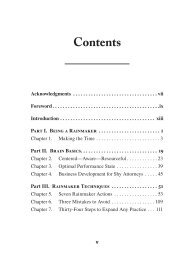(Bk Business) Carol Kinsey Goman Ph.D.-The Nonverbal Advantage_ Secrets and Science of Body Language at Work -Berrett-Koehler Publishers (2008)
Just
Just
You also want an ePaper? Increase the reach of your titles
YUMPU automatically turns print PDFs into web optimized ePapers that Google loves.
2 <strong>The</strong> <strong>Nonverbal</strong> <strong>Advantage</strong><br />
<strong>The</strong> silent signals <strong>of</strong> nonverbal communic<strong>at</strong>ion tend to<br />
reveal underlying motives <strong>and</strong> emotions—fear, honesty, joy,<br />
indecision, frustr<strong>at</strong>ion—<strong>and</strong> much more. <strong>The</strong> tiniest gestures,<br />
like the way your co-workers st<strong>and</strong> or enter a room, <strong>of</strong>ten<br />
speak volumes about their confidence, self-worth, <strong>and</strong> credibility.<br />
And the way you sit, st<strong>and</strong>, or look <strong>at</strong> others reveals<br />
more about your true intent than you may realize.<br />
<strong>Body</strong> <strong>Language</strong> Expertise<br />
I’ve been an expert <strong>at</strong> using body language from the day I was<br />
born. You may be surprised to learn th<strong>at</strong> you have been, too.<br />
As infants we displayed a variety <strong>of</strong> facial expressions to signal<br />
our moods <strong>and</strong> needs, pointed <strong>at</strong> objects <strong>of</strong> interest, <strong>and</strong><br />
bonded with our mothers through the power <strong>of</strong> eye contact.<br />
As children we assimil<strong>at</strong>ed those gestures <strong>and</strong> expressions<br />
th<strong>at</strong> were appropri<strong>at</strong>e in our families <strong>and</strong> in our cultures.<br />
<strong>The</strong>n, as we grew older, we learned to refine (<strong>and</strong> disguise)<br />
signals th<strong>at</strong> were too obvious or unwelcome.<br />
We did most <strong>of</strong> this unconsciously.<br />
It wasn’t until I was in a master’s program in college, preparing<br />
to be a therapist, th<strong>at</strong> I became aware <strong>of</strong> the nonverbal<br />
signals th<strong>at</strong> I’d been sending <strong>and</strong> receiving all my life.<br />
Training in Neuro-Linguistic Programming <strong>and</strong> Ericksonian<br />
approaches to hypnosis <strong>and</strong> psychotherapy taught me how<br />
to observe people’s eye movements, facial expressions, <strong>and</strong><br />
body postures to discover their inner motiv<strong>at</strong>ion <strong>and</strong> resistance.<br />
When I began consulting to business organiz<strong>at</strong>ions<br />
<strong>and</strong> speaking to n<strong>at</strong>ional <strong>and</strong> then intern<strong>at</strong>ional audiences,<br />
I paid more <strong>at</strong>tention to my own body language so th<strong>at</strong> the<br />
gestures, postures, <strong>and</strong> expressions I used would accur<strong>at</strong>ely<br />
reflect the message I wanted to get across. I use these same<br />
insights <strong>and</strong> techniques with the executives <strong>and</strong> managers I<br />
now coach.




